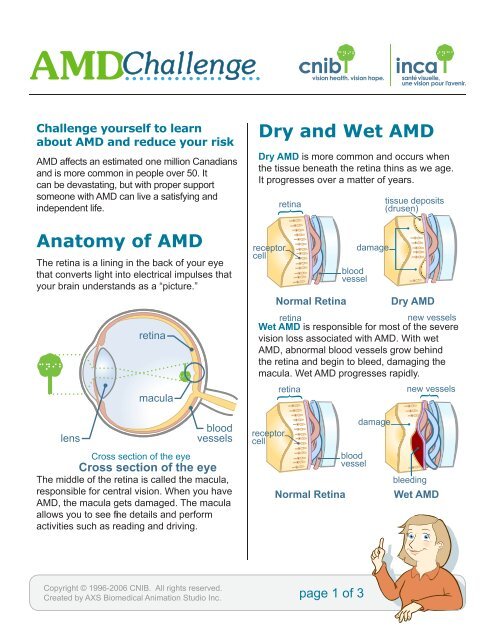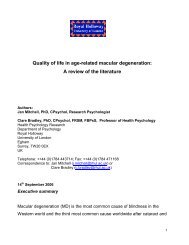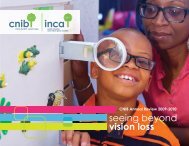Create successful ePaper yourself
Turn your PDF publications into a flip-book with our unique Google optimized e-Paper software.
Challenge yourself to learn<br />
about <strong>AMD</strong> <strong>and</strong> reduce your risk<br />
<strong>AMD</strong> affects an estimated one million Canadians<br />
<strong>and</strong> is more common in people over 50. It<br />
can be devastating, but with proper support<br />
someone with <strong>AMD</strong> can live a satisfying <strong>and</strong><br />
independent life.<br />
<strong>Anatomy</strong> <strong>of</strong> <strong>AMD</strong><br />
The retina is a lining in the back <strong>of</strong> your eye<br />
that converts light into electrical impulses that<br />
your brain underst<strong>and</strong>s as a “picture.”<br />
lens<br />
retina<br />
macula<br />
blood<br />
vessels<br />
Cross section <strong>of</strong> the eye<br />
Cross section <strong>of</strong> the eye<br />
The middle <strong>of</strong> the retina is called the macula,<br />
responsible for central vision. When you have<br />
<strong>AMD</strong>, the macula gets damaged. The macula<br />
allows you to see fine details <strong>and</strong> perform<br />
activities such as reading <strong>and</strong> driving.<br />
<strong>Dry</strong> <strong>and</strong> <strong>Wet</strong> <strong>AMD</strong><br />
<strong>Dry</strong> <strong>AMD</strong> is more common <strong>and</strong> occurs when<br />
the tissue beneath the retina thins as we age.<br />
It progresses over a matter <strong>of</strong> years.<br />
receptor<br />
cell<br />
retina<br />
Normal Retina<br />
blood<br />
vessel<br />
damage<br />
tissue deposits<br />
(drusen)<br />
<strong>Dry</strong> <strong>AMD</strong><br />
retina<br />
new vessels<br />
<strong>Wet</strong> <strong>AMD</strong> is responsible for most <strong>of</strong> the severe<br />
vision loss associated with <strong>AMD</strong>. With wet<br />
<strong>AMD</strong>, abnormal blood vessels grow behind<br />
the retina <strong>and</strong> begin to bleed, damaging the<br />
macula. <strong>Wet</strong> <strong>AMD</strong> progresses rapidly.<br />
receptor<br />
cell<br />
retina<br />
Normal Retina<br />
blood<br />
vessel<br />
damage<br />
new vessels<br />
bleeding<br />
<strong>Wet</strong> <strong>AMD</strong><br />
Copyright © 1996-2006 <strong>CNIB</strong>. All rights reserved.<br />
Created by AXS Biomedical Animation Studio Inc.<br />
page 1 <strong>of</strong> 3
Symptoms<br />
Symptoms vary from person to person.<br />
Detecting <strong>AMD</strong><br />
The Amsler grid is a simple test you can do at<br />
home. Download it at<br />
www.cnib.ca/amsler<br />
normal<br />
vision<br />
vision<br />
with <strong>AMD</strong><br />
They include:<br />
• Blurred or fuzzy vision<br />
• Straight lines that appear wavy or crooked<br />
• Decreased contrast or colour sensitivity<br />
• Difficulty seeing at a distance<br />
• A small, but growing, blind spot in the<br />
centre <strong>of</strong> vision<br />
Regular checkups are essential, since <strong>AMD</strong><br />
can be present without symptoms.<br />
• See your eye care pr<strong>of</strong>essional at least<br />
every two years.<br />
• If you are over 50 or have <strong>AMD</strong> in your<br />
family, a yearly visit is recommended.<br />
Copyright © 1996-2006 <strong>CNIB</strong>. All rights reserved.<br />
Created by AXS Biomedical Animation Studio Inc.<br />
page 2 <strong>of</strong> 3
Risk factors<br />
Cure <strong>and</strong> treatment<br />
Non-modifiable risk factors are things you<br />
can’t change:<br />
• Increased Age<br />
• Female gender<br />
• Family history <strong>of</strong> <strong>AMD</strong><br />
• Light skin <strong>and</strong> eye colouring, race, <strong>and</strong><br />
other factors are also being studied.<br />
You can change modifiable risk factors:<br />
• Quit smoking: it’s a major risk factor for<br />
<strong>AMD</strong>.<br />
• Protect your eyes: Wear a hat <strong>and</strong><br />
sunglasses with 98 per cent UV protection.<br />
• Eat well, <strong>and</strong> stay active:<br />
• Maintain a low-fat diet <strong>and</strong> a healthy<br />
weight.<br />
• Eat brightly coloured vegetables <strong>and</strong><br />
fish such as tuna <strong>and</strong> salmon.<br />
And don’t forget your regular eye exams!<br />
There is no cure for <strong>AMD</strong>. There are<br />
treatments available that can reverse, slow or<br />
halt its progression in some cases. If you have<br />
<strong>AMD</strong>, talk to your eye care pr<strong>of</strong>essional about<br />
what might work for you. And contact <strong>CNIB</strong><br />
right away<br />
(1-800-563-2642 or info@cnib.ca) so you <strong>and</strong><br />
your family can receive vital support.<br />
More information<br />
• <strong>CNIB</strong> (www.cnib.ca/amd)<br />
• <strong>AMD</strong> Alliance International<br />
(www.amdalliance.org)<br />
• Canadian Opthalmological Society<br />
(www.eyesite.ca)<br />
• Canadian Association <strong>of</strong> Optometrists<br />
(www.opto.ca)<br />
Copyright © 1996-2006 <strong>CNIB</strong>. All rights reserved.<br />
Created by AXS Biomedical Animation Studio Inc.<br />
page 3 <strong>of</strong> 3











